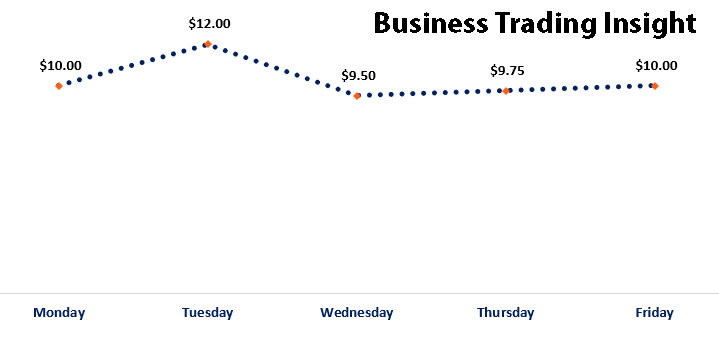In the dynamic world of financial markets, one of the most fundamental metrics that traders and investors rely on is Net Change. This metric, though seemingly simple, plays a crucial role in assessing how an asset’s price evolves over a given period, providing insights into market sentiment, volatility, and potential future price movements.
For anyone involved in trading — whether short-term speculators, swing traders, or long-term investors—understanding how to analyze Net Change is essential to making informed decisions. In this comprehensive article, we will explore the concept of Net Change in detail, its significance, calculation, and application across various markets and trading strategies. We will also dive into how to use it in conjunction with other market indicators, as well as discuss how volatility impacts price shifts and the risks involved in relying solely on this metric.
By the end of this article, you will have a deeper understanding of Net Change and be equipped with the tools to incorporate it into your trading strategy effectively.
What is Net Change in Trading?
Net Change refers to the difference between the opening and closing price of an asset during a specific period — typically a day, week, or month. It essentially represents the price variation over the trading session. The formula to calculate Net Change is simple:
Net Change = Closing Price − Opening Price
For example:
If a stock opens at $100 and closes at $110, the price shift is +$10.
If the stock opens at $100 and closes at $95, the asset price movement is -$5.
While this formula may seem straightforward, the insights it provides are invaluable for market participants. Net Change helps traders understand whether an asset is gaining or losing value, and to what extent, over a given period. This information is critical for gauging market sentiment and for making trading decisions.

Importance of Net Change for Traders and Investors
Net Change is more than just a price difference — it’s a reflection of market dynamics. Traders use it to assess the market’s sentiment during a particular session or period. If the market change is positive, it signals bullish sentiment, with more buyers than sellers driving the price higher. Conversely, a negative movement in asset price indicates a bearish sentiment, where sellers dominate, pushing the price lower.
Beyond sentiment, Net Change provides insights into market momentum, trends, and volatility. For instance, if a stock has a consistent positive Net Change over several days, this could indicate the start of an uptrend. Similarly, if the price dynamics show a consistent downward shift, it could suggest a downtrend or a reversal.
Objective of the Article
This article aims to explain how Net Change can be used to analyze price movements, identify trading opportunities, and assess risk. We will cover how price changes are calculated, how they fit into technical analysis, how they relate to volatility, and how to incorporate them into trading strategies across different timeframes. Finally, we will discuss the limitations and risks associated with relying solely on Net Change, and how traders can use it effectively as part of a broader, more comprehensive trading strategy.
Basics of Net Change in Trading
How is Net Change Calculated?
As stated earlier, Net Change is simply the difference between the closing price and the opening price of an asset. This can be done on any timeframe, whether it’s daily, weekly, monthly, or even intra-day. Let’s look at a few examples of calculating Net Change in different asset classes.
Example 1: Stock Market (Daily Price Change)
- Opening Price: $150
- Closing Price: $160
- Net Change = $160 − $150 = +10
In this case, the stock price increased by $10 during the day, signaling positive market sentiment and an upward price movement.
Example 2: Forex Market (Currency Pairs)
- Opening Price: 1.3000 (EUR/USD)
- Closing Price: 1.3050
- Net Change = 1.3050 − 1.3000 = +0.0050 (50 pips)
In this scenario, the Euro has appreciated against the US Dollar by 50 pips, indicating an increase in demand for the Euro relative to the US Dollar.
Example 3: Commodity Market (Gold)
- Opening Price: $1,800
- Closing Price: $1,815
- Net Change = $1,815 − $1,800 = +15
Gold has risen by $15 during the trading session, signaling a positive price movement in the precious metals market.
These examples show how Net Change can be used to quantify price movement in different markets, offering traders valuable insights into market dynamics.

Application of Net Change in Technical Analysis
How Net Change Helps with Chart Analysis
In technical analysis, traders use price fluctuations to identify trends, reversals, and entry/exit points. Net Change plays a key role in this process, as it indicates whether the asset is experiencing upward or downward momentum. By analyzing price movements over time, traders can identify the strength of a trend, the potential for trend continuation, or signs of a reversal.
Net Change and Trend Strength
If price change shows consistent upward movement over several periods, this indicates a strong bullish trend. Conversely, consistent negative price shifts suggest a bearish trend. For example, if the difference in price for a stock over the past week has been consistently positive, this could indicate that the stock is in a strong uptrend.
Traders often use tools like Moving Averages (MAs) to further validate trends. If Net Change aligns with the direction of the MA (for example, the price is above a long-term MA), it reinforces the uptrend. On the other hand, a decline in asset price movement could signal a potential reversal or weakening of the trend.
Example: Moving Averages and Net Change
A simple moving average (SMA) is calculated by averaging the closing prices over a specific number of periods (e.g., 50 or 200 days). When the price is consistently above the SMA and the market change is positive, it signals a strong upward trend. However, if the price starts dipping below the SMA while Net Change turns negative, this could indicate a trend reversal.
Net Change and Candlestick Patterns
Candlestick charts are a popular tool in technical analysis, and price variation is integral to interpreting them. A candlestick consists of a body and wicks, with the body representing the opening and closing price. A long body (a significant price shift) indicates strong market sentiment, while a small body suggests indecision or weak momentum. By combining candlestick patterns with Net Change, traders can gain deeper insights into the market’s direction.
The Role of Net Change in Volatility Analysis
What is Market Volatility?
Market volatility refers to the magnitude of price fluctuations in a given asset over a period of time. High volatility is characterized by large price changes, while low volatility refers to more stable, smaller movements. Volatility is crucial for traders because it affects both risk and opportunity—large price movements can offer higher profits, but they also come with greater risk.
Net Change and Volatility
A large Net Change often signals high volatility, meaning the price of an asset has shifted significantly during the period. For example, if a stock’s price increases by $10 in a single day, the Net Change is large, indicating strong volatility. Similarly, a small Net Change (e.g., $0.50 on a $100 stock) suggests lower volatility.
Traders use volatility to assess potential risk and adjust their strategies. For instance, high volatility may warrant a more conservative approach with smaller position sizes, while low volatility may present opportunities for larger trades.
Trading Strategies for Different Volatility Levels
- High Volatility:
During periods of high volatility, traders often use news-based strategies or algorithmic trading. News releases, earnings reports, or geopolitical events can drive large price movements, creating trading opportunities. However, the risk is higher, and strategies like scalping (taking advantage of small price changes) or using stop-loss orders become critical to mitigate losses. - Low Volatility:
In low volatility environments, traders may rely on trend-following strategies, such as moving averages or RSI-based trading. These strategies help identify gradual price movements and trends. With lower volatility, the risk of sudden price swings is reduced, allowing for more stable trades and the possibility of accumulating profits over a longer period.
Volatility Indicators Based on Net Change
One of the most widely used volatility indicators is the Average True Range (ATR). ATR measures the average range between high and low prices over a set period. High ATR values indicate high volatility, while low ATR values suggest low volatility. Combining Net Change with ATR helps traders understand the potential magnitude of future price movements and tailor their risk management strategies accordingly.

How Net Change is Used in Different Trading Strategies
Day Trading and Short-Term Strategies
For day traders, Net Change is crucial in identifying short-term opportunities. By tracking price fluctuations throughout the trading day, day traders can spot trends and market shifts that present an opportunity for quick profits. Large price movements within the first few hours of trading often signal strong momentum, making them prime opportunities for entering and exiting trades rapidly.
These price changes provide traders with insights into short-term market dynamics, allowing them to make fast decisions that capitalize on momentum. Traders will often use price variation as a sign of strong trends, which are ideal for fast-paced, short-term strategies.
Swing Trading
Swing traders use Net Change to identify medium-term price movements. By analyzing price shifts over several days or weeks, swing traders can gauge the potential for price swings in either direction. A consistent positive movement in asset price could indicate an uptrend, while a consistent negative change in asset value might signal a downtrend.
In swing trading, understanding how prices evolve over a series of trading sessions helps traders plan for profitable entries and exits based on anticipated market shifts.
Long-Term Investing
Long-term investors use Net Change to assess broader market trends. A stock or asset with a consistent positive price variation over months or years is likely to show long-term growth potential. By tracking price dynamics over an extended period, investors can make more informed decisions about when to enter or exit positions based on market movement.
For long-term investors, Net Change serves as a tool for identifying assets that are steadily gaining value, giving them insights into broader market trends that signal long-term investment opportunities.
Risks and Limitations of Relying on Net Change
While Net Change is a valuable tool, it does have limitations. It doesn’t capture the full picture of market sentiment or intermediate price variations, which may be significant for short-term traders. Moreover, Net Change can be influenced by external factors like market manipulation, economic news, and geopolitical events. For instance, sudden price fluctuations driven by news events may not necessarily reflect the true market value of an asset and can result in false signals for traders.
Price shifts caused by such external influences may distort the information provided by Net Change, leading traders to misinterpret market conditions.
Managing Risks with Net Change
One of the ways to mitigate risks when using Net Change is to combine it with other indicators and analysis methods. For instance, traders often use moving averages, RSI, and ATR to confirm signals and assess the strength of price movements. Additionally, stop-loss orders and position sizing based on Net Change can help manage risk and protect profits in volatile conditions.
Using Net Change alongside other technical indicators enhances a trader’s ability to assess not just price fluctuations but also broader market context, which is key to successful risk management.
Conclusion
In conclusion, Net Change is an essential tool in a trader’s toolkit, providing valuable insights into price movements, market sentiment, and volatility. Whether you’re day trading, swing trading, or making long-term investments, understanding Net Change and how to apply it across different markets and strategies can significantly enhance your trading decisions.
However, it’s important to remember that Net Change should not be used in isolation. Combining it with other technical indicators and maintaining a comprehensive risk management plan will help mitigate potential risks and optimize your chances of success. By using Net Change wisely, traders can unlock a deeper understanding of market dynamics and make more informed decisions in the fast-paced world of trading.



